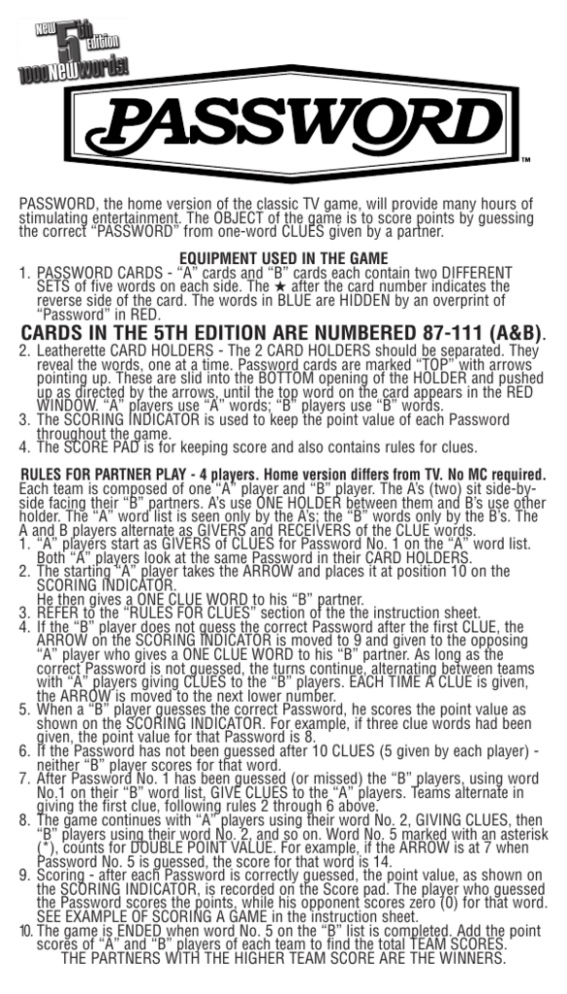
PASSWORD, the home version of the classic TV game, will provide many hours of
stimulating entertainment. The OBJECT of the game is to score points by guessing
the correct “PASSWORD” from one-word CLUES given by a partner.
EQUIPMENT USED IN THE GAME
1. PASSWORD CARDS - “A” cards and “B” cards each contain two DIFFERENT
SETS of five words on each side. The ★ after the card number indicates the
reverse side of the card. The words in BLUE are HIDDEN by an overprint of
“Password” in RED.
CARDS IN THE 5TH EDITION ARE NUMBERED 87-111 (A&B).
2. Leatherette CARD HOLDERS - The 2 CARD HOLDERS should be separated. They
reveal the words, one at a time. Password cards are marked “TOP” with arrows
pointing up. These are slid into the BOTTOM opening of the HOLDER and pushed
up as directed by the arrows, until the top word on the card appears in the RED
WINDOW. “A” players use “A” words; “B” players use “B” words.
3. The SCORING INDICATOR is used to keep the point value of each Password
throughout the game.
4. The SCORE PAD is for keeping score and also contains rules for clues.
RULES FOR PARTNER PLAY - 4 players. Home version differs from TV. No MC required.
Each team is composed of one “A” player and “B” player. The A’s (two) sit side-byside facing their “B” partners. A’s use ONE HOLDER between them and B’s use other
holder. The “A” word list is seen only by the A’s; the “B” words only by the B’s. The
A and B players alternate as GIVERS and RECEIVERS of the CLUE words.
1. “A” players start as GIVERS of CLUES for Password No. 1 on the “A” word list.
Both “A” players look at the same Password in their CARD HOLDERS.
2. The starting “A” player takes the ARROW and places it at position 10 on the
SCORING INDICATOR.
He then gives a ONE CLUE WORD to his “B” partner.
3. REFER to the “RULES FOR CLUES” section of the the instruction sheet.
4. If the “B” player does not guess the correct Password after the first CLUE, the
ARROW on the SCORING INDICATOR is moved to 9 and given to the opposing
“A” player who gives a ONE CLUE WORD to his “B” partner. As long as the
correct Password is not guessed, the turns continue, alternating between teams
with “A” players giving CLUES to the “B” players. EACH TIME A CLUE is given,
the ARROW is moved to the next lower number.
5. When a “B” player guesses the correct Password, he scores the point value as
shown on the SCORING INDICATOR. For example, if three clue words had been
given, the point value for that Password is 8.
6. If the Password has not been guessed after 10 CLUES (5 given by each player) neither “B” player scores for that word.
7. After Password No. 1 has been guessed (or missed) the “B” players, using word
No.1 on their “B” word list, GIVE CLUES to the “A” players. Teams alternate in
giving the first clue, following rules 2 through 6 above.
8. The game continues with “A” players using their word No. 2, GIVING CLUES, then
“B” players using their word No. 2, and so on. Word No. 5 marked with an asterisk
(*), counts for DOUBLE POINT VALUE. For example, if the ARROW is at 7 when
Password No. 5 is guessed, the score for that word is 14.
9. Scoring - after each Password is correctly guessed, the point value, as shown on
the SCORING INDICATOR, is recorded on the Score pad. The player who guessed
the Password scores the points, while his opponent scores zero (0) for that word.
SEE EXAMPLE OF SCORING A GAME in the instruction sheet.
10. The game is ENDED when word No. 5 on the “B” list is completed. Add the point
scores of “A” and “B” players of each team to find the total TEAM SCORES.
THE PARTNERS WITH THE HIGHER TEAM SCORE ARE THE WINNERS.
GAME FOR THREE PLAYERS - A Variation of the Standard 4 player game
In this game, ONE player GIVES CLUES to TWO PLAYERS who compete in guessing
the CORRECT PASSWORD. Use the same rules for clues and scoring as in the
standard 4 player game.
1. The GIVING player, using any word list, gives ONE CLUE to both RECEIVING
players AT THE SAME TIME.
2. The RECEIVERS may make ONE GUESS for each clue given, if desired, a receiving
player may PASS, and not give a response.
3. As soon as each guess has been made, the GIVING player indicates whether it is
the correct PASSWORD. The player to respond FIRST with the correct password,
receives the point score for the word. If both players respond with the correct
Password simultaneously, both receive the point score.
4. A Game consists of 5 Passwords, the fifth word scoring DOUBLE.
THE WINNER IS THE PLAYER WITH THE HIGHER SCORE.
The team of Jenny and Dan have WON the game. Their total score is 43 points,
while Jake and Kim scored only 29 points. The “A” players, Jenny and Jake scored
as shown. Jenny scored on words 2 and 4. Jake scored on words 1 and 5. the fifth
word was guessed by Jake when the ARROW was at position 6 on the indicator, so
his score for that word is doubled, making it a 12 point word. Zero (0) was scored
on word 3 as neither guessed it within 10 clues. For the “B” players, Dan guessed
word 1, 3, and 5 (Doubled), while Kim scored on words 2 and 4.
RULES FOR CLUES
The Password is always a SINGLE word, not hyphenated and NOT a proper noun.
1. The CLUE word must be a SINGLE, non-hyphenated word. For example, the clue
“well-to-do” would not be allowed.
2. If the opposing team CHALLENGES a clue as being 2 words or hyphenated, it is
looked up in the dictionary. The point value of the Password at that time goes to
the team that was right.
3. Proper nouns may be used as CLUE words. Thus, “Hitchcock” may be given for
the Password “mystery”.
4. No part or form of the Password may be used as a clue. “Chemist” could not be
used for
“chemistry”, “steal” could not be used for “stolen”, and “monk” could not be
used for “monkey”.
5. Specific gestures and pantomime are NOT ALLOWED. For example, a player may
not “curve” with his hands. Players ARE ALLOWED to show facial expressions
and use voice inflections. For example, a player may whisper “silence” to get
“quiet” as a response.
6. A previously given CLUE word may be repeated by either player. It is also proper
to link a clue to previous CLUE words. For example, “race”, “horse”, and “rider”
may be three separate CLUE words linked together to get “jockey” as a response.
7. NO SPELLING of a CLUE word is allowed. If a FORM of the Password is given as
a RESPONSE, the responding player is given ONE CHANCE to correct the word to
the exact Password. For example, if “mud” is given for the Password “muddy”,
the player is told that they have given a form of the word and have one chance to
correct it. If they don’t come up with “muddy” in their next response, then the
Password is thrown out and no one scores on that word.
Password™ is a trademark of FremantleMedia Operations BV.
Licensed by FremantleMedia Enterprises. www.fremantlemedia.com
©2008 FremantleMedia North America, Inc. All rights reserved.
Based on the FremantleMedia television program ‘Password’™
Distributed by Endless Games, Inc. South Amboy, New Jersey • 732-721-1032
Visit Our Website at: www.endlessgames.com
The Endless Games Logo is a RegisteredTrademark of Endless Games, Inc.





